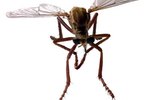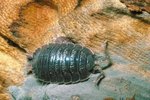
If you ever find yourself in the middle of an arid desert, the presence of lots of tiny flies everywhere could prove to be extremely frustrating, even preventing you from keeping your eyes properly open. Eye gnats, for example, are miniscule genus Hippelates or Liohippelates insects that are prevalent in the deserts of many areas throughout the United States.
Spotting Eye Gnats
These tiny flies are barely visible, with typical lengths of between 1/8 and 1/16 of an inch. Their bodies are predominantly glossy gray or black, but they have conspicuously bright limbs -- usually brownish-orange or yellow. Eye gnats' wings are transparent. They share a resemblance to houseflies, but are markedly smaller.
Big Pests
Even though they're small, mature female eye gnats are big pests. Their diets consist of human and animal bodily fluids, including blood, mucus, sweat and pus. Because of that, they're commonly seen circling people and animals, trying to gain access to their eyes, mouths or other openings on quests for protein. Eye gnats gravitate toward dampness on their victims. They don't stop easily, which is why many think of them as such pesky inconveniences. Eye gnats are incapable of lacerating peoples' skin, however, as they're not biters. Mature males have different feeding habits than the females, opting for flowers instead. Sightings of the boys, as a result, are highly uncommon.
Habitat for Eye Gnats
Eye gnats typically live in deserts, although they're also found in agricultural areas. These desert inhabitants become more prominent between April and November each year, while cooler areas with more vegetation see a shorter period of activity, starting in June instead of April. They're especially busy at the start of the day and then again a little before evening falls. Eye gnats are often drawn to shade, and are also frequently seen in the middle of thick vegetation.
Fungus Gnats in the Desert
Not all little flies in the desert are eye gnats. Fungus gnats also regularly make their homes there. Many of them live in the Sonoran Desert of the United States' southwest, sharing habitat with eye gnats. Fungus gnats in the Sonoran Desert often spend their time close to moist soil that receives plentiful shade. One easy tip for discerning between fungus and eye gnats involves your eyes. Fungus gnats, unlike eye gnats, keep away from them and stick to plants.
References
- University of California Integrated Pest Management Program: Eye Gnats
- University of California Agriculture and Natural Resources: New Invasions of Eye Gnats in Southern California
- North Carolina State University Integrated Pest Management Program: Eye Gnats
- County of San Diego: Eye Gnats
- County of San Diego: Eye Gnat -- Frequently Asked Questions
- Texas A&M AgriLife Extension: Eye Gnat
- Merck Veterinary Manual: Eye Gnats
- Maricopa County Cooperative Extension: Fungus Gnats
Photo Credits
-
Jupiterimages/Photos.com/Getty Images



